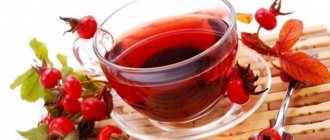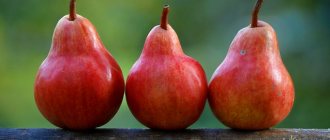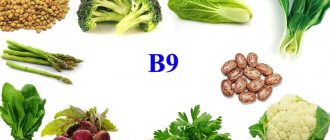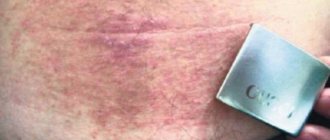Despite the fact that chamomile has an anti-inflammatory effect, and decoctions from it are often used to treat various allergic manifestations, sometimes it itself can be an allergen.
Most often, an allergy to chamomile is observed in a child, especially in the first months after birth, when parents add chamomile infusion to baths for disinfection. This type of allergy is not the most common and quite often allergic symptoms occur in an erased form, so a thorough diagnosis is required.
Does chamomile cause allergies?
This plant has contraindications, like other traditional medicines. An allergy to chamomile is a rare occurrence, since the plant is a fighter against various types of skin rashes. People with gastritis should not use chamomile infusions, and if a person suffers from diarrhea, then this plant will also not bring benefits.
Chamomile is found in many drugs and cosmetics, so an allergy to chamomile is not immediately determined. Most often, an allergic reaction occurs due to changes in the immune system and the ingress of various bacteria.
Who has it and why does it happen?
Allergy to chamomile infusion
This type of allergy, like many others, develops due to improper functioning of the immune system. As for flowers, an immune reaction to them develops mainly in people whose bodies react this way to many other plants, since in this case the main allergen is pollen, and it often does not matter which plant it comes from. It occurs with chamomile infusion either due to individual intolerance or when it is used too often. An infant may be allergic to chamomile decoction if baths from it are used too often, as well as due to individual intolerance.
The effects of chamomile
Chamomile is a herbaceous plant with many branches - stems. The flowers look like baskets with a yellow core. Pharmaceutical chamomile is found everywhere. Only inflorescences - baskets - are collected. Ready-made dried chamomile can be purchased at any pharmacy. However, pharmaceutical chamomile has contraindications. The chamomile allergen has a fairly strong effect on the body. With long-term use and a significant increase in the recommended dose, an allergy to chamomile may occur. A person develops irritability, weakness, and headache.
Headache.
Why is chamomile tea dangerous for a child?
Chamomile is often used in child care. Chamomile tea has a positive effect on the formation of the nervous system. The child sleeps well after taking this tea. Also, children are less likely to suffer from stomach disorders. Therefore, mothers try to accustom their children to this drink.
Children's bodies are different, just like adults' bodies, and what is useful for one may not always be useful for another. If, after taking the tea, a child is allergic to chamomile, then it is necessary to stop giving chamomile tea.
Risk factors
Chamomile pollen is a major allergen. A reaction can occur when pollen enters the respiratory tract or gastrointestinal tract. Young children even experience skin rashes.
Often the disease manifests itself due to changes in the human immune system, which occur due to the action of various bacteria. The disease can develop into a chronic form if treatment measures are not taken in a timely manner.
Allergies may occur to chamomile tea. Doctors often use it for diagnosis.
Manifestation of allergy to chamomile in infants
To avoid an allergy to chamomile in an infant, you need to use it very carefully, since babies are very susceptible to various drugs. Chamomile is commonly used to bathe young children if they suffer from skin rashes. It has a calming effect and improves baby's sleep. You can bathe your baby in chamomile decoction only from the second week, when the umbilical wound has healed.
To prevent an allergy to chamomile in an infant, you need to give decoctions for the treatment of colic in babies from small portions, for example, a teaspoon and watch the child’s reaction. If there is no redness or rash, then your child is not allergic to chamomile.

Rashes on the body of a baby.
Main symptoms of chamomile allergy
Symptoms of an allergy to chamomile can appear at any time of the year, since it is a very common remedy and is widely used in many medicines and cosmetics. Let's look at them:
Respiratory allergies occur after an allergen enters the respiratory system. This allergy manifests itself as:
- sneezing;
- itching in the nose;
- watery nasal discharge;
- cough;
- wheezing in the lungs.
These symptoms can be confused with signs of acute respiratory infections. The main difference is that allergies do not cause an increase in body temperature, nasal discharge is clear, and sneezing is repeated.
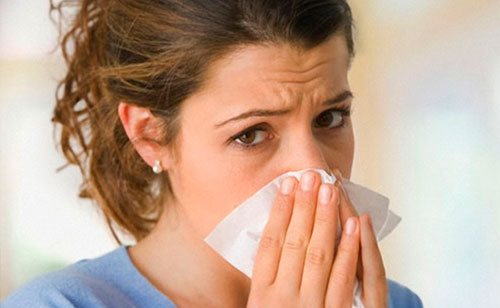
Prolonged runny nose.
Allergic conjunctivitis manifests itself as:
- burning in the eyes;
- tearfulness;
- swelling of the eyelids.
Dermatosis is accompanied by rashes and irritations on the skin:
- redness of the skin;
- skin itching;
- peeling;
- blisters;
- rash.
Enteropathy occurs due to an allergic reaction of the gastrointestinal tract. Appears as:
- nausea;
- vomiting;
- intestinal colic;
- diarrhea or constipation.
Treatment of allergies with folk remedies
A decoction of string for allergy sufferers:
Traditional medicine recommends drinking a decoction of the string instead of tea or coffee for a very long time (at least a year). The decoction of the string cannot be stored and should only be drunk fresh.
Juice or infusion of fragrant celery root for the treatment of allergies and allergic urticaria:
This is a proven and completely safe traditional medicine. The juice is squeezed from the fresh root. Take 1-2 teaspoons 3 times a day, 30 minutes in advance. before meals. The infusion is prepared as follows: 2 tbsp. Infuse tablespoons of crushed roots in a glass of cold water for 2 hours, strain. Drink 1/3 glass 3 times a day before meals. Use for allergic urticaria.
Infusion of the herb celandine for allergies:
1 tbsp. Brew a spoonful of herbs with 2 cups of boiling water, leave for 4 hours. Traditional medicine recommends drinking 1/4-1/2 cup in the morning and evening.
Infusion of calendula officinalis inflorescences for allergies:
pour 10 g. inflorescences 1/2 cup boiling water, brew for 1-2 hours. Take 1 tbsp. spoon 2-3 times a day.
Shilajit for the treatment of allergies:
dilute mumiyo in a concentration of 1 g. for 1 liter of warm water. A good mummy dissolves without the appearance of turbidity. Take the solution in the morning once a day with warm milk. Dosage for children: aged 1-3 years - 50 ml, 4-7 years - 70 ml, 8 years and older - 100 ml. Mumiyo has a diuretic and laxative effect. Skin rashes can be lubricated with a solution at the rate of 1 g. per 100 ml of water. The course of treatment is at least 20 days. Avicenna recommended treatment for 20 days in spring and autumn.
Infusion of chamomile inflorescences for the treatment of allergies:
Pour 1 tablespoon of inflorescences with a glass of boiling water, steam for 20-30 minutes, traditional medicine recommends taking this infusion 1 tbsp. spoon 2-3 times a day.
Peppermint herb infusion for treating allergies:
pour 10 g. herbs 1/2 cup boiling water, steam for 20-30 minutes, traditional medicine recommends taking this infusion 1 tbsp. spoon 3 times a day.
Herbal mixture for the treatment of dust allergies:
herbal medicine recommends for the treatment of allergies a collection consisting of centaury - 5 parts, St. John's wort - 4 parts, dandelion root - 3 parts, horsetail - 2 parts, corn stalks - 1 part, chamomile - 1 part, rose hips - 4 parts. 4 tbsp. Pour a spoonful of the mixture into a glass of water and let it brew overnight. In the morning, put on fire and bring to a boil (do not boil!). Then wrap for 4 hours and strain. Drink 1 glass a day in 3 divided doses, before meals. The infusion can be prepared immediately for 2-3 days and stored in the refrigerator. When taking this medication, there may be side effects such as itching or increased agitation. They go away in about a month. Taking the drug for at least 6 months. It is better not to drink alcohol at this time. And you can get rid of itching with the help of anesthetic ointments.
Willow branches for skin allergies in children:
In the morning, boil 5 liters of water, add 300-400 g. willow branches and leave to infuse until evening. In the evening, heat to the desired temperature and bathe children in this decoction. After 3 procedures there is a noticeable improvement. The course of treatment is 10 days.
Herbal mixture for dust allergies:
herbal medicine recommends collecting herbs:
centaury – 5 tbsp. spoons, St. John's wort - 4 tbsp. spoons, dandelion (root) - 3 tbsp. spoons, corn silk - 1 tbsp. spoon, horsetail - 2 tbsp. spoons, rose hips (fruits) - 2 tbsp. spoons, burdock (root) - 3 tbsp. spoons
Grind rose hips, dandelion roots and burdock root through a meat grinder. Mix the whole mixture well, 2 tbsp. spoons of the mixture pour 500 ml of cold water and let stand overnight. In the morning, put on fire, bring to a boil, cover for 4 hours and strain. Take 1 glass per day 20-30 minutes before meals in 3 divided doses. Store the infusion in the refrigerator. The course of treatment is up to 6 months. During treatment with this collection, do not drink alcohol. This collection can be given to children.
Anti-allergic “blood purifying” coffee made from dandelion and burdock roots:
herbalists recommend taking burdock (root) – 1 part, dandelion (root) – 1 part
Roast the roots in the oven and crush in a mortar or grind in a coffee grinder. 2 tbsp. Pour spoons of burdock and dandelion root powder into three glasses of water. Let it brew overnight, boil for 10 minutes in the morning, leave for 10 minutes. Be sure to drink 100 ml with milk and sugar before meals and at night.
Allergic runny nose . This disease is characterized by itching, tingling in the nose, difficulty breathing through the nose, copious watery discharge from the nasal cavity, and continuous sneezing. Often there is a headache, irritability, itching of the eyelids, and lacrimation. Treatment of this disease with traditional medicine is carried out in 2 stages:
STAGE 1 IS PREPARATION FOR TREATMENT
, duration 1-1.5 months:
During this period, it is necessary to follow a diet that limits allergenic foods, in particular egg whites, sea fish, kidneys, pork, tomatoes, strawberries, cocoa, chocolate, etc.
It is also necessary to carry out therapeutic fasting for 24-36 hours once a week.
rinse the intestines with a decoction of herbs once a week using 2 liter enemas (dandelion root and leaves - 10 g, St. John's wort - 5 g, chicory herb - 5 g), at the rate of 1 tablespoon of the mixture per 200 ml of water, leave for 1 hour, strain and use for rinsing. Add 250 ml of infusion to 2 liters of boiled water.
Carry out “blind” probing of the gallbladder 1-2 times a week, which is performed as follows: slightly warm 1 bottle of mineral water and drink in small sips, after which you need to lie on your right side and apply a warm heating pad for 30 minutes.
Daily intake of anti-allergic tea:
string grass – 5 g., chamomile flowers – 10 g., licorice root – 8 g., elecampane root and rhizome – 6 g., sage leaf – 3 g., lemon balm leaf – 3 g., horsetail herb – 10 g. .
mix all herbs, 1 tbsp. pour 200 ml of boiling water over a spoonful of the collection, leave in a thermos for 10 hours, strain, take 100 ml 4-5 times a day warm, take the collection for 1 month.
STAGE 2 – NON-SPECIFIC HYPOSENSITIZATION (REDUCING SENSITIVITY TO ALLERGENS)
, duration 1-1.5 months:
During this period, you need to take adaptogens (tinctures of ginseng or Schisandra chinensis, or Leuzea) 10-15 drops in the morning on an empty stomach. Take glyceram tablets (the drug is prepared from the roots and rhizomes of licorice) 0.2 g. 3-4 times a day;
Inject histaglobulin from 0.1 to 1 ml subcutaneously every other day.
Rinse the nasal cavity with propolis solution (200 ml of warm boiled water - 2 grams of sodium bicarbonate, 18 drops of 10% alcohol solution of propolis) daily - 1-2 times a day.
Instead of tea, take a freshly prepared infusion of the tripartite herb: 1 teaspoon per 1 glass of boiling water, leave for 20 minutes and take the entire portion 3 times a day.
Instill into the nose: 3% solution of boric acid 10 ml, 0.1% solution of adrenaline hydrochloride 10 drops and 3% solution of silver nitrate 6-8 drops 2 times a day.
Take a decoction of motherwort herb: 1 tablespoon per 200 ml of water - take 100 ml at 18-19 and 21-22 hours.
Do inhalations (for the nose, do not forget to inhale through the mouth, exhale through the nose, a course of 10-12 procedures). For inhalation, you can use infusions of the following composition:
chamomile flowers - 5 gr., wild rosemary flowers - 4 gr., yarrow grass -15 gr., calendula flowers - 10 gr.
200 gr. collection, pour 200 ml of boiling water, leave for an hour, strain, use 100 ml per 1 inhalation.
Aloe and raw egg white ointment against eczema, skin allergies, itchy skin:
Mash 2 aloe leaves with 1 raw egg white until smooth. Store in refrigerator for no more than 3 days. Apply a thin layer to problem areas.
Ointment made from beeswax, olive oil and boiled yolk against all skin diseases:
take 100 grams of beeswax (about the size of a matchbox), 100 grams of olive oil and 1 boiled yolk. Heat beeswax in a water bath until liquid, add olive oil and 1 mashed boiled egg yolk. Mix everything thoroughly until smooth. Keep refrigerated. The ointment has a shelf life of at least 1 month.
A decoction of sorrel leaves helps with allergies, reduces itching and rashes:
a proven traditional medicine - take 100 grams. fresh leaves, pour 0.5 liters of boiling water, cook for 10 minutes and drink half a glass 4 times a day. However, if you are prone to the formation of stones in the gall bladder and kidneys, sorrel is contraindicated.
A decoction of lungwort flowers for the treatment of allergies:
take 1 tablespoon of flowers, pour 0.5 liters of boiling water, place in a thermos for 15 minutes, then pour into a glass jar with a lid and leave for another 30 minutes. Traditional healers advise drinking this decoction half a glass 3-4 times a day.
This plant has contraindications, like other traditional medicines. An allergy to chamomile is a rare occurrence, since the plant is a fighter against various types of skin rashes. People with gastritis should not use chamomile infusions, and if a person suffers from diarrhea, then this plant will also not bring benefits.
Chamomile is found in many drugs and cosmetics, so an allergy to chamomile is not immediately determined. Most often, an allergic reaction occurs due to changes in the immune system and the ingress of various bacteria.
Chamomile is a herbaceous plant with many branches - stems. The flowers look like baskets with a yellow core. Pharmaceutical chamomile is found everywhere. Only inflorescences - baskets - are collected. Ready-made dried chamomile can be purchased at any pharmacy. However, pharmaceutical chamomile has contraindications. The chamomile allergen has a fairly strong effect on the body. With long-term use and a significant increase in the recommended dose, an allergy to chamomile may occur. A person develops irritability, weakness, and headache.
Women and young girls rinse their hair with chamomile decoction. After this, the hair becomes vibrant and shiny. But if you use the decoction too often, you may develop an allergy to the chamomile decoction. Itching and redness of the scalp begins. It is necessary to increase the time between rinses or stop them.
Chamomile is often used in child care. Chamomile tea has a positive effect on the formation of the nervous system. The child sleeps well after taking this tea. Also, children are less likely to suffer from stomach disorders. Therefore, mothers try to accustom their children to this drink.
Children's bodies are different, just like adults' bodies, and what is useful for one may not always be useful for another. If, after taking the tea, a child is allergic to chamomile, then it is necessary to stop giving chamomile tea.
To avoid an allergy to chamomile in an infant, you need to use it very carefully, since babies are very susceptible to various drugs. Chamomile is commonly used to bathe young children if they suffer from skin rashes. It has a calming effect and improves baby's sleep. You can bathe your baby in chamomile decoction only from the second week, when the umbilical wound has healed.
To prevent an allergy to chamomile in an infant, you need to give decoctions for the treatment of colic in babies from small portions, for example, a teaspoon and watch the child’s reaction. If there is no redness or rash, then your child is not allergic to chamomile.
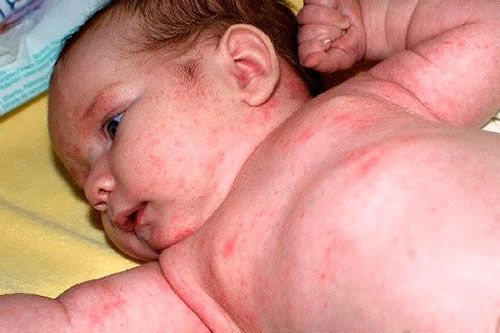
Rashes on the body of a baby.
Symptoms of an allergy to chamomile can appear at any time of the year, since it is a very common remedy and is widely used in many medicines and cosmetics. Let's look at them:
Respiratory allergies occur after an allergen enters the respiratory system. This allergy manifests itself as:
- sneezing;
- itching in the nose;
- watery nasal discharge;
- cough;
- wheezing in the lungs.
These symptoms can be confused with signs of acute respiratory infections. The main difference is that allergies do not cause an increase in body temperature, nasal discharge is clear, and sneezing is repeated.
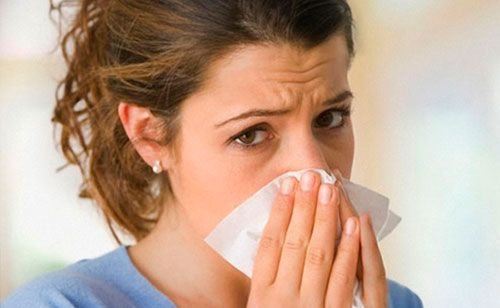
Allergic conjunctivitis manifests itself as:
Dermatosis is accompanied by rashes and irritations on the skin:
- redness of the skin;
- skin itching;
- peeling;
- blisters;
- rash.
Enteropathy occurs due to an allergic reaction of the gastrointestinal tract. Appears as:
- nausea;
- vomiting;
- intestinal colic;
- diarrhea or constipation.
Many people believe that allergies are a harmless disease and do not need to be treated. But that's not true. It is dangerous due to its complications. The disease can provoke bronchial asthma, eczema, and low blood pressure. Treatment should begin by avoiding contact with the allergen and visiting an allergist to prescribe medication.
An effective method of treating chamomile allergies are folk remedies:
To do this, you need to take 1 teaspoon of duckweed powder (the grass needs to be washed) and add it to 50 milligrams of vodka. The infusion should steep for 7 days. Then strain and add 15-20 drops per quarter cup of water. Drink three times a day.
If you find an error in the text, be sure to let us know about it. To do this, simply highlight the text with the error and press Shift + Enter or simply click here . Thank you very much!
Thank you for notifying us about the error. We will fix everything soon and the site will become even better!
Post Views: 311
How to treat chamomile allergy
Many people believe that allergies are a harmless disease and do not need to be treated. But that's not true. It is dangerous due to its complications. The disease can provoke bronchial asthma, eczema, and low blood pressure. Treatment should begin by avoiding contact with the allergen and visiting an allergist to prescribe medication.
An effective method of treating chamomile allergies are folk remedies:
To do this, you need to take 1 teaspoon of duckweed powder (the grass needs to be washed) and add it to 50 milligrams of vodka. The infusion should steep for 7 days. Then strain and add 15-20 drops per quarter cup of water. Drink three times a day.
Features of the disease
Dried flowers contain a large number of different substances.
These are oils, acids, enzymes and proteins. All of them can trigger a negative reaction in the body. Predicting the occurrence of an allergy to chamomile in a baby, teenager or adult is quite problematic. No one can predict how the organism makes up the components of a flower. Most often, the immune system of an allergic person reacts positively to the components of chamomile flowers. If the human body perceives another traditional medicine as an allergen, then this remedy can really help in the fight against allergies. But if a person is hypersensitive to one of the components of the plant, then its use will lead to an exacerbation of the disease. If decoctions and infusions with chamomile are used to treat allergy symptoms, this will only worsen the situation.
https://www.youtube.com/watch?v=8yxpzv5bVi4
Chamomile decoctions and tea should be taken with extreme caution by people with multifactorial allergies. In this case, the disease is caused by several allergens at once.
Pregnant women should not take chamomile or medications containing it. It contains essential oil, which can be harmful to both the expectant mother and her baby. Oil provokes the growth of estrogen, so the likelihood of pregnancy failure increases.
Allergies have two phases: early and late. The process of an allergic reaction is divided into the following stages:
- Immunological. Once allergens enter the body, they are distributed throughout the body. The human immune system becomes more sensitive.
- Biochemical. It occurs after repeated intake of infusion or decoction. Mediator substances are released. The main ones are histamine, prostaglandins and cytokines.
- Clinical. Only at this stage do symptoms of an allergic reaction appear.
Many people ask whether chamomile is an allergen or not? After all, it is recommended to drink it for various diseases. Chamomile is an allergen, but not a strong one. Much more often the body reacts negatively to citrus fruits or aloe. Signs of an allergy to chamomile are mild.
The main symptoms of a child’s allergy to chamomile are rashes on the cheeks. The baby becomes restless, often cries and is capricious. Rhinitis and conjunctivitis in infants is extremely rare. Flatulence, abdominal pain and intestinal colic are also possible. If you feel worse, you should consult a doctor.
It is extremely rare for a child to develop allergic rhinitis to plant pollen. For the most part, chamomile is hypoallergenic. Infants react more often to the plant; the older the child becomes, the less chance of developing an allergic reaction.
For the first time, when bathing a baby, only 100 g of chamomile decoction is added to the water. If there is no reaction after bathing, then next time you can add a little more. When using nasal instillations with chamomile, start with one drop. If the child feels well, the dose can be doubled. The first dose of chamomile infusion should be no more than one teaspoon. Afterwards they reach the norm recommended by the pediatrician.
Many people let allergies take their course, believing that there is no great danger. But that's not true. The disease is dangerous due to its complications. If left untreated, bronchial asthma and eczema develop, and blood pressure drops.
If a reaction to chamomile is detected, the first step is to stop any contact with it. Each subsequent use of chamomile preparations leads to an increase in allergy symptoms. Sensitization of the body is also possible; it begins to react to other types of allergens. Theoretically, ignoring the symptoms and continuing to use chamomile can lead to anaphylactic shock. The amount of tea, infusion or decoction consumed in this case does not matter.
During treatment, the allergist prescribes antihistamines, bronchodilators, sorbents (see in more detail “Antihistamines in the treatment of allergies: mechanism of action and classification”). In severe cases, hormonal medications are used.
Bathing with chamomile is contraindicated for such a child.
You should not bathe a newborn or infant with allergies with chamomile. Due to the immature immune system of the baby’s body, there is a possibility that due to such procedures he will develop hypersensitivity to chamomile. You should bathe with chamomile infusion only after the allergy is over.
Trying to rid a child of allergies by bathing in chamomile is pointless. Allergies can only be eliminated by identifying the allergen and taking measures to eliminate contact with it.
Herbal treatment has many advantages - a gentle, gentle effect on the body, lack of toxicity, and the possibility of long-term use without addiction.
The advantage is that herbs contain components in the form that the body needs. But we must understand that the use of herbs cannot always completely overcome the disease. Most often, this method helps relieve symptoms and prevent complications.
The use of plants for allergies helps:
- reduce inflammation of the eyes, nasal mucosa, bronchi and digestive tract;
- enhance the effect of primary therapy drugs and mitigate their side effects;
- cleanse the stomach and liver of toxins, helminths and protozoal infestations;
- remove itching, swelling and rashes on the skin.
The course of taking herbal medicines is designed for a long time - from 3 to 6 months. This approach helps to gradually reduce the body's sensitivity to allergens and prepare for periods of exacerbations.
Different plants are used for different reactions. The choice depends on the identified allergen, symptoms and primary treatment. First of all, you should get rid of irritating factors, but this is not always possible, so treatment becomes a problem.
Allergy to dust
Often a reaction to dust is mistaken for a cold. As a result, if the diagnosis is incorrect, a mild form of the disease can lead to chronic bronchial asthma. If this form is diagnosed, infusions and decoctions of calendula and dandelion, nettle, and butterbur will help alleviate it, for example, the following:
- A glass of boiling water for two tablespoons. spoons of calendula flowers, leave for several hours. Take a regular spoon several times a day.
- 100 g of dandelion flower heads per 1/2 liter of boiling water. Leave for about ten hours. Drink half a glass before meals.
- Grind the dry butterbur raw material into powder. Take a teaspoon 4 times a day.
- A teaspoon of nettle stems and leaves (dried or fresh) per glass of water. Boil, cool, drink on an empty stomach.
If such herbs and compositions are used for dust allergies, serious complications can be avoided.
Reaction to pollen
This form is seasonal and begins during the flowering period of the plant, the pollen of which is individually intolerant. The main difference from other forms is that pollen settles not only on the mucous membrane of the respiratory organs, but also on the eyeballs, causing conjunctivitis. In these cases, string, rose hips, raspberry root, sage and celery juice help well. Some recipes used for hay fever:
- A teaspoon of string per glass of boiling water, let it brew for an hour. You can drink in any quantity.
- Leave dried rosehips (40g) in 200g of hot water for four hours. Drink instead of tea throughout the day.
- Boil raspberry root (50g) in 200g of water over low heat for forty minutes. Drink two teaspoons three times a day.
- Boil dried sage leaves (20g) and leave until completely cooled. Strain and rinse your nose as if you have a runny nose.
- Drink 100 ml of celery juice twice a day before meals.
Dermatitis, eczema, and drug toxicity occur not only when irritating substances come into contact with the skin. Elements that cause a reaction enter the body with food, medications, and polluted air. They are absorbed into the blood and the skin is affected from the inside. You can pay attention to the following recipes using herbs against skin allergies in adults:
- Infuse 3 large bay leaves for 2 hours in a glass of boiling water. Drink morning and evening.
- For a liter of boiling water you need to take three tbsp. spoons of tricolor violet flowers. Leave for up to 2 hours. Can be used for baths, lotions and compresses.
- Boil crushed drupe root (50g) in water (1/2 l) for 15 minutes. Use in compresses and baths.
Irritations and rashes on the face are especially unpleasant. To cope with such manifestations, apply compresses and wash with decoctions of string, dill and celandine. Good results are obtained when using chamomile for allergies on the skin of the face. Chamomile has an anti-inflammatory effect, so it helps quickly eliminate irritation. You can make decoctions with it, wash your face, and apply it for a certain time. For allergies on the face, you can also use ointments with plants:
- Melt 50 grams of Vaseline, add tbsp. spoon of calendula flowers. Apply the prepared ointment until the face is completely cleansed.
- Heat beeswax (2 spoons), add oil (100g) and crushed nettles, dry, or preferably recently collected (1 spoon). Apply to facial skin until allergy disappears.
